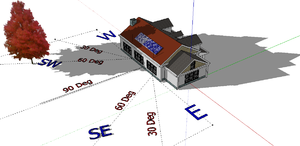
The use of distributed solar photovoltaic (PV) systems is growing more common as solar energy conversion efficiencies increase while costs decrease. Thus, PV system installations are increasing in non-optimal locations such as those potentially shaded with trees. Tree-related shading can cause a significant power loss and an increasing collection of laws have been enacted and are under development to protect the right of PV owners to solar access. This paper provides a new method to predict the shading losses for a given tree species, orientation to a PV array, and geographic location using existing free tools in order to assist in the prevention of conflicts by creating an environment where PV systems and trees can coexist while maximizing PV performance. This methodology is applied to a case study in the Midwest US. Tree growth characteristics including height, crown width, and growth rate were investigated. Minimum planting distances were quantified based on tree species and orientation of planting with respect to the PV system and conclusions were drawn from the results. This novel open low-cost method to predict and prevent tree shading from negatively impacting the performance of roof-mounted PV systems assists in planning of technical design.
Methods[edit | edit source]
Simulations are made in Google Sketchup8 because of low cost of reproducing the methodology as there is free access to both the software and 3D models online. The Google Sketchup models were validated with Heliodon 2.7-03, which is a proven method to determine the shadow pattern of trees [1]. You can determine tree shading for your own solar array and choose the best trees for your home using only free Google Sketchup if you follow our protocol in the paper.
Results[edit | edit source]
For full results see the paper - it provides detailed tree planting guidelines and limits of geometry for existing trees.
For resolving or preventing conflicts between PV owners and neighbours with trees:
- "When considering the potential for conflict between PV systems owners adjacent to neighbours with trees or considering planting trees, there are several approaches that may help to dissolve tension. First, is simply to supply accurate information on the impact of trees on the solar energy system to all parties. The methods used in this paper can be replicated by home owners looking at a specific house, PV system (or other solar energy system), tree species/ages and tree locations. Thus the need to replant, change the location of the array (e.g. mount closer to the top of the roof if it is only going to cover part of a south-facing roof top), trim the tree, or use some other corrective measure can be quantified. The authors speculate that providing gifts of acceptable trees to neighbours may improve goodwill so that the use of lawyers can be avoided. For example, fruit or nut trees such as an apple tree would provide both aesthetic value, lawn shade, and added value (food). The necessary trimming of the tree to ensure the added value of food production is maximized would also ensure that the tree did not grow to a height that impeded solar energy production."

